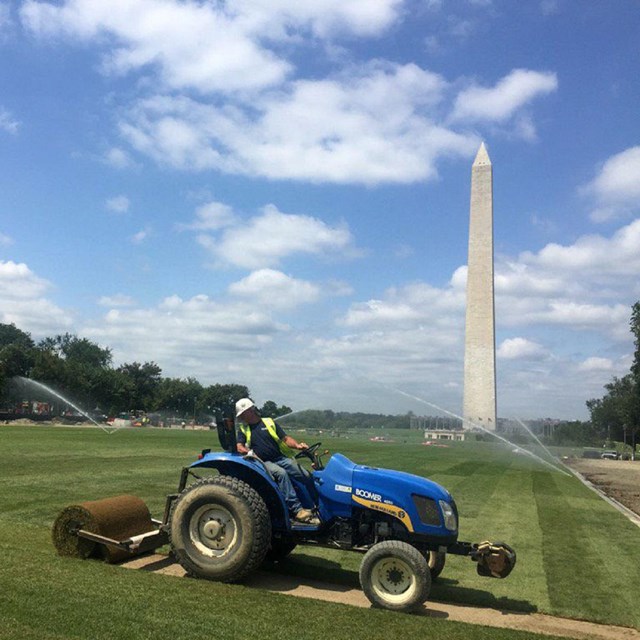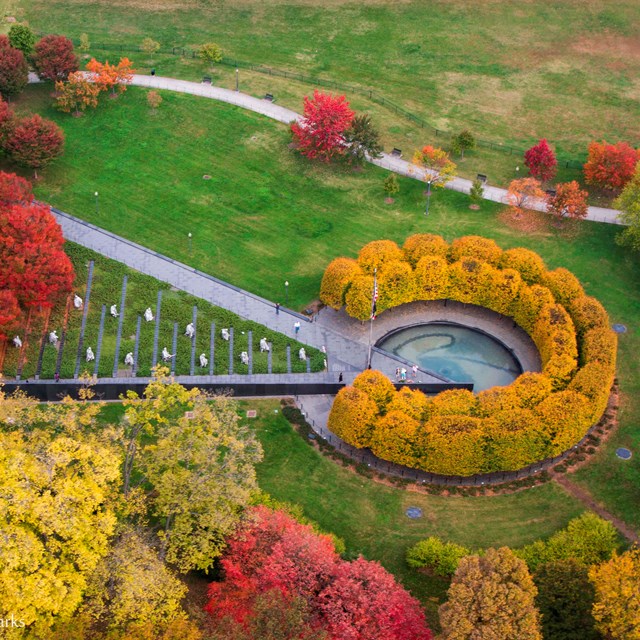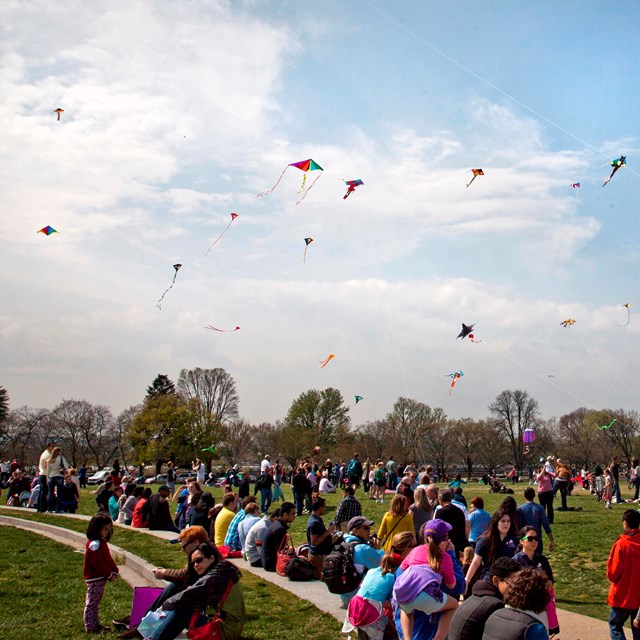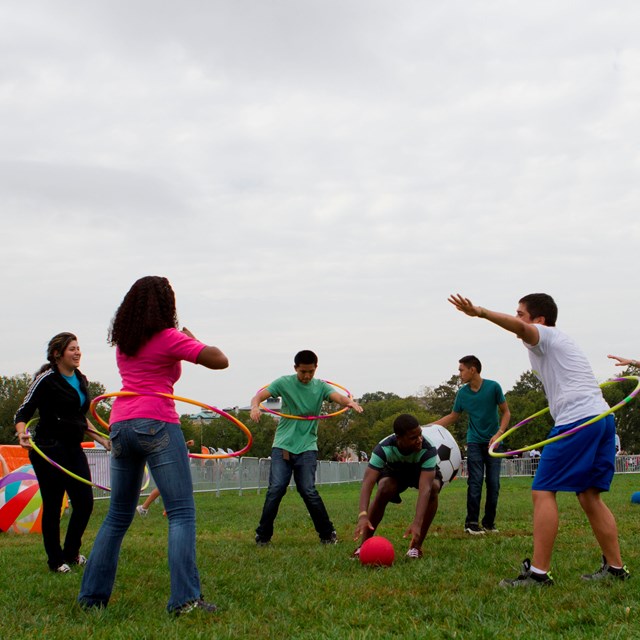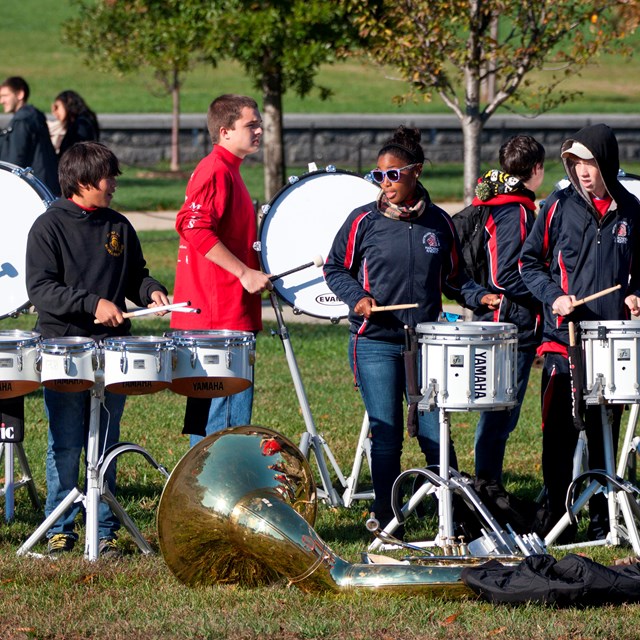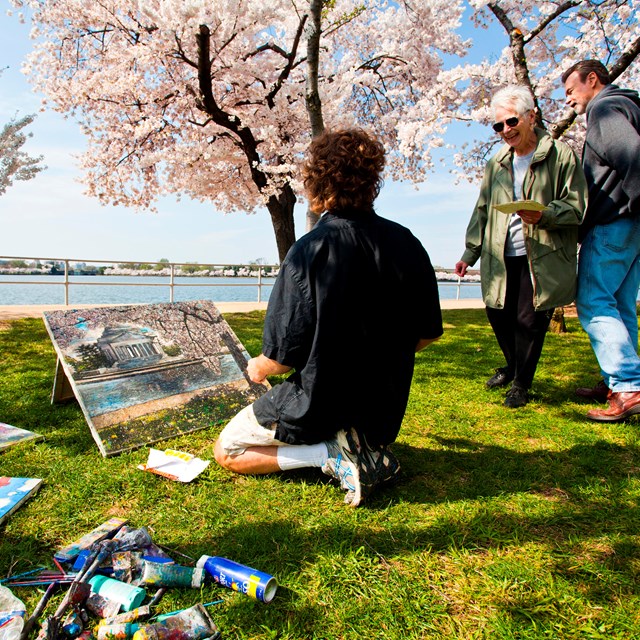|
This is Chapter 1 Section 1 of the Turf Management and Operations Guide for the National Mall and Memorial Parks, a comprehensive guide and manual intended for National Park Service employees, permit holders, and others using the lawn areas of the National Mall and Memorial Parks. 1.1 Protecting Level 1 Turf AreasLevel 1 areas in the National Mall and Memorial Parks consist of turf areas in the monumental core. Memorials such as the Jefferson, Lincoln, Korean War, World War II, and the Washington Monument are considered Level 1 Turf Areas. In addition, iconic landscapes such as the Mall and along the Reflecting Pool shall be considered Level 1. Uptown Parks shall be managed as level 1.
Level 1 areas such as the Mall are highly desirable for all kinds of uses and have been typically scheduled for over 800 days of permitted use per calendar year (based on multiple events happening on the same days). On the Mall the result was the decline of turf health and visual appearance and deteriorating soil conditions. By 2006, conditions were judged to be unsatisfactory to the National Park Service, Department of the Interior, Congress and the American public. The large number of permitted activities limited maintenance practices to renovation of half of the center turf panels every other year by taking the panels out of use for the winter. This approach, based on recovery and not prevention, has not been effective.
Between events, NPS will perform pre-event preparation and post-event restorative and preventative maintenance on level 1 turf areas. The cost of any maintenance outside normal operating procedures in order to support or recover from an event, shall be considered part of the cost recovery for the event and is the responsibility of the Permittee. 1.2 Introduction to the Level 1 areas within the National Mall, the NPS Regulatory Process, and Park Resource ProtectionThe National Mall’s landscapes and open spaces provide a stunning visual setting in our Nation’s capital. “Here orchestrated events involving thousands of people or spontaneous ones with just a few participants are equally fitting. Space here is ever changing – at one point defined, at the next open and casual-but it is seldom limited to a single or even predominating use. In this sense the Mall’s space is neutral, allowing people freely to engage themselves in myriad ways…”The Mall in Washington, 1791-1991 15 (Richard Longstreth, ed.)(2002). 1.3 Mall SiteLocated in the heart of Washington DC, the Mall is defined as the area bound on the east by Third Street, on the west by 14th Street, on the north by Madison Drive, and on the south by Jefferson Drive. The following maps illustrate areas in which Permittees may hold events. Where applicable, use limitations are noted. For additional details on event capacity, refer to section 3.3/Table 7.
1.3.1 Non-Turf Areas for Temporary StructuresNon-turf areas such as walkways and hardscape panels are the preferred location for events of all types, particularly events using structures. Non-turf areas are highlighted in orange on the diagram below. Total square footage of non-turf areas is approximately 800,000 square feet. This includes four hardscape panels (3, 8, 20, and 40), as well as the north-south and east-west walkways. 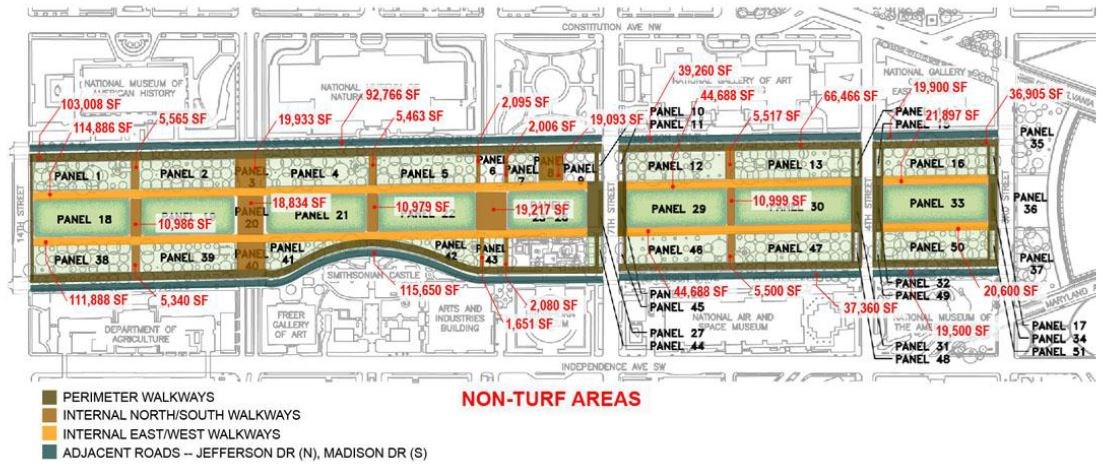
The map is a visual reference of non-turf areas of the National Mall between 14th and 3rd Streets and Madison and Jefferson Drives in Washington, DC. For more information about the map or using these spaces for permitted activities, contact the National Mall and Memorial Parks' Permits Management Office at 202-245-4715.
Perimeter Walkways are highlighted in dark brown on the map. Perimeter walkways include the east-west walkways along Jefferson Drive on the southside of the street from 14th Street to 3rd Street; the east-west walkways along Madison Drive on the north side of the street from 14th Street to 3rd Street; the north-south walkway along 14th Street on the east side of the street from Madison Drive to Jefferson Drive; the north-south walkways along both sides of 7th Street and 4th Street from Madison Drive to Jefferson Drive; and the north-side walkway along 3rd Street on the west side of the street from Madison Drive to Jefferson Drive. Internal North/South Walkways are highlighted in light brown on the map. They include north-south walkways from Madison Drive to Jefferson Drive halfway between 14th and 12th Streets; on 12th Street; halfway between 12th and 9th Streets; on 9th Street; and halfway between 7th and 4th Streets. Internal East/West Walkways are highlighted on the map in yellow. They include interior east-west walkways on the National Mall between Madison and Jefferson Avenues from 14th Street to 7th Street. Adjacent Roads of Jefferson Drive North and Madison Drive South are highlighted on the map in greyish-blue. 1.3.2 Turf Area Locations for Temporary StructuresStructures are permitted on all walkways and hardscape. Structures can be permitted on turf panels with limitations listed in Section 3.3. The yellow areas on the diagram below indicate areas where structures are permitted; the red areas indicate areas where structures are permitted but with use limitations to protect the turf. Structures are not allowed in the tree panels. 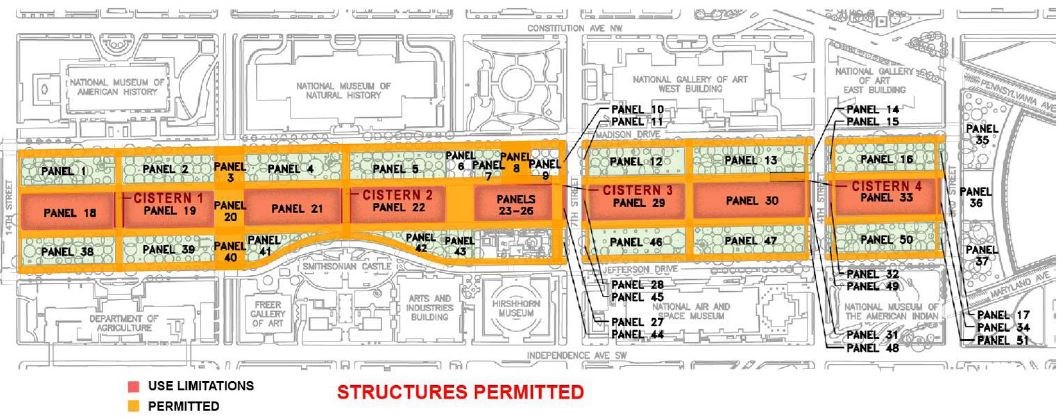
The map is a visual reference for where structures are permitted on National Mall between 14th and 3rd Streets and Madison and Jefferson Drives in Washington, DC. For more information about the map or using these areas for permitted activities, contact the National Mall and Memorial Parks' Permits Management Office at 202-245-4715.
Areas with use limitations for structures are highlighted on the map in red. Lawn areas between the internal walkways running east-west from 14th Street to 3rd Street between Madison and Jefferson Avenues generally have use limitations for structures. Permitted areas for structures are highlighted on the map in orange. Structures are permitted on the majority of north-south and east-west perimeter and internal walkways on the National Mall from 14th Street to 3rd Street between Madison and Jefferson Avenues. 1.3.3 Mall Hardscape Measurements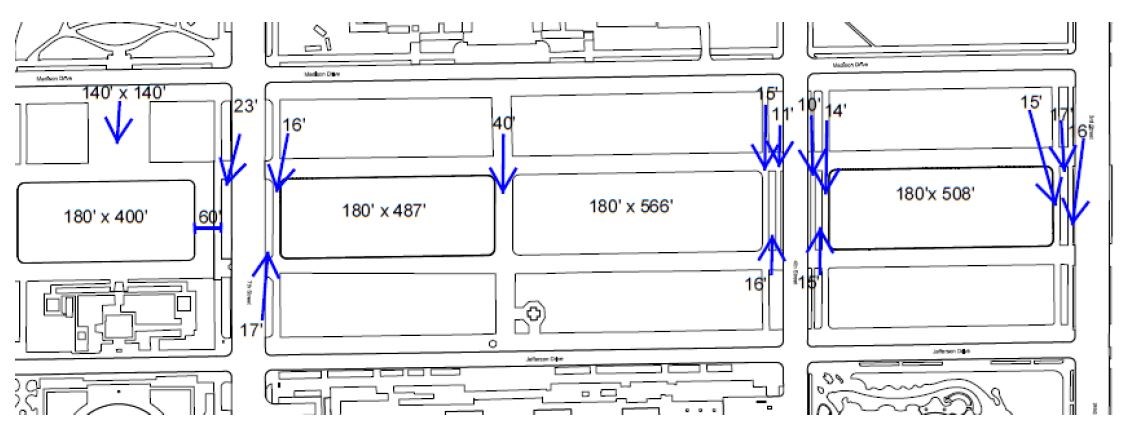
The map is a visual reference of hardscape measurements on the National Mall between 3rd Street and the 9th Street Tunnel and Madison and Jefferson Drives in Washington, DC. For more information about the map or using these areas for permitted activities, contact the National Mall and Memorial Parks' Permits Management Office at 202-245-4715.
Hardscape areas and measurements include: A 140-feet by 140-feet area next to Madison Drive between 9th and 7th Streets A 180-feet by 400-feet area between Madison and Jefferson Drives and 9th and 7th Streets A 60-feet wide north-south walkway on the west side of 7th Street A linear 23-feet wide area along the west side of 7th Street A linear 17-feet wide area along the east side of 7th Street A 16-feet wide north-south walkway on the east side of 7th Street A 180-feet by 487-feet area between Madison and Jefferson Avenues just east of 7th Street A 40-feet wide north-wouth walkway between 7th and 4th Streets A 180-feet by 566-feet area between Madison and Jefferson Avenues just west of 4th Street A 15-feet wide north-south walkway on the west side of 4th Street A linear 16-feet wide area on the west side of 4th Street A 11-feet wide walkway along the west side of 4th Street A 10-feet wide walkway along the east side of 4th Street A linear 15-feet wide area on the east side of 4th Street A 14-feet wide north-south area on the east side of 4th Street A 180-feet by 508-foot area between Madison and Jefferson Avenues and 4th and 3rd Streets A 15-feet wide walkway on the west side of 3rd Street A linear 17-feet wide area on the west side of 3rd Street A 16-feet wide walkway along 3rd Street Mall 3rd to 9th Street Tunnel 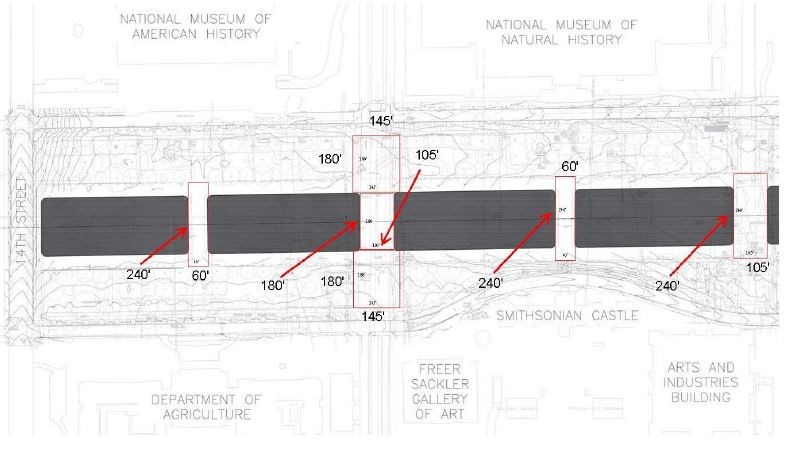
The map is a visual reference of hardscape areas on the National Mall between 9th and 14th Streets and Madison and Jefferson Drives in Washington DC. For more information about the map or questions related to using this area for permitted events, contact the National Mall and Memorial Parks' Permits Management Office at 202-245-4715.
Hardscape areas and measurements include: A 240-feet by 60-feet area halfway between 14th Street and 12th Street A 180-feet by 145-feet area along Madison Drive above the 12th Street Tunnel A 180-feet by 105-feet area between Madison and Jefferson Drives above the 12th Street Tunnel A 180-feet by 145-feet area along Jefferson Drive above the 12th Street Tunnel A 240-feet by 60-feet area halfway between 12th Street and 9th Street A 240-feet by 105-feet area above the 9th Street Tunnel Mall 9th Street Tunnel to 14th Street 1.3.4 Locations for Setup of Chairs or Other SeatingSetup of chairs or other seating is permitted on all walkways, hardscape panels, and turf panels (with protective turf covering). The orange areas on the diagram below indicate areas where seating setup is permitted. Appropriate turf cover must be used when seating is placed on turf panels2. 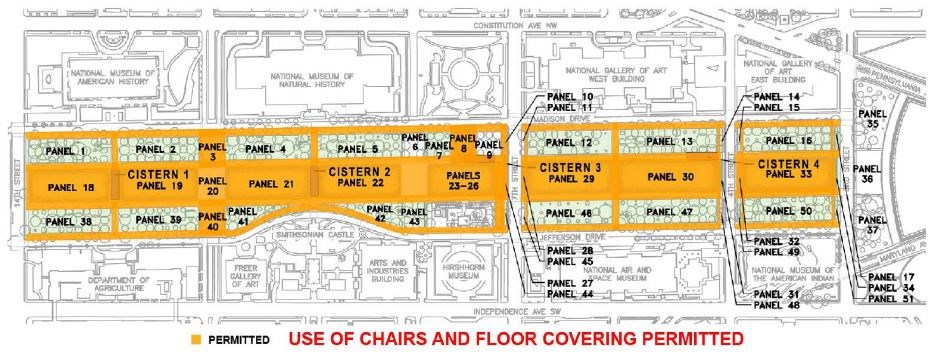
The map is a visual reference of where standing is permitted on the National Mall between 14th and 3rd Streets and Madison and Jefferson Drives in Washington, DC. For more information about the map or using the space for permitted activities, contact the National Mall and Memorial Parks' Office of Permits Management at 202-245-4715.
Areas where seating setup is permitting is highlighed in orange on the map. Seating is generally permitted on perimeter and internal walkways and sections of turf in between internal walkways in all areas between 14th and 3rd Streets and Madison and Jefferson Drives. An additional area along Madison Drive between 9th and 7th Streets is also highlighted. 1.3.5 Locations for Pedestrian Standing AreasStanding is permitted on all panels and walkways, as illustrated in orange in the diagram below. If weather conditions or crowd numbers warrant it (1 person per 5 square feet), the event may be required to install protective flooring. 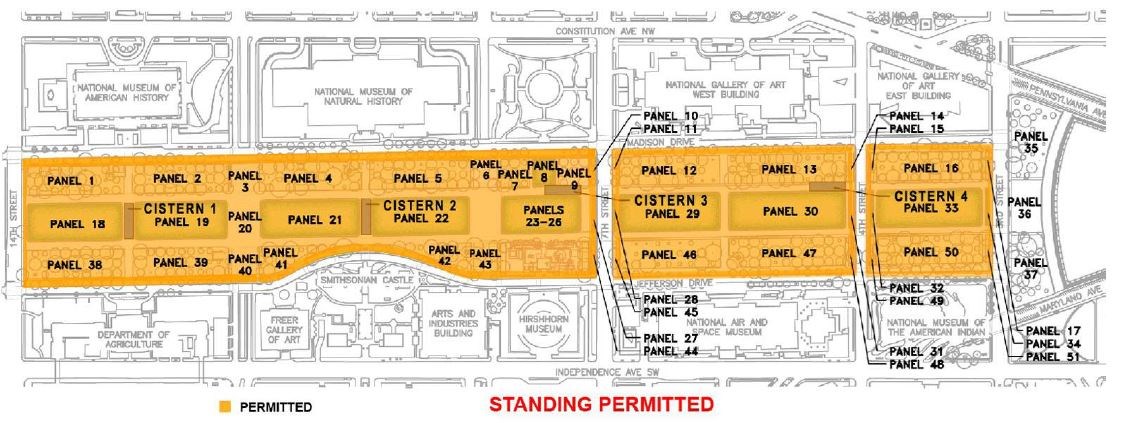
The map is a visual reference of where standing is permitting on the National Mall between 14th and 3rd Streets and Madison and Jefferson Drives in Washington, DC. For more information about the map or using these areas for permitted activities, contact the National Mall and Memorial Parks' Permits Management Office at 202-245-4715.
Areas were standing is permitted are highlighted in orange on the map. Standing is generally permitted in all parkland areas between 14th and 3rd Streets and Madison and Jefferson Drives with the exception of roads open to vehicular traffic. 1.3.6 Level 1, 2, 3 Turf AreasLevel 1 guidelines are the basis for all guidelines and they are presented in this guide.
Level 3 areas, in addition to Level 2 allow:
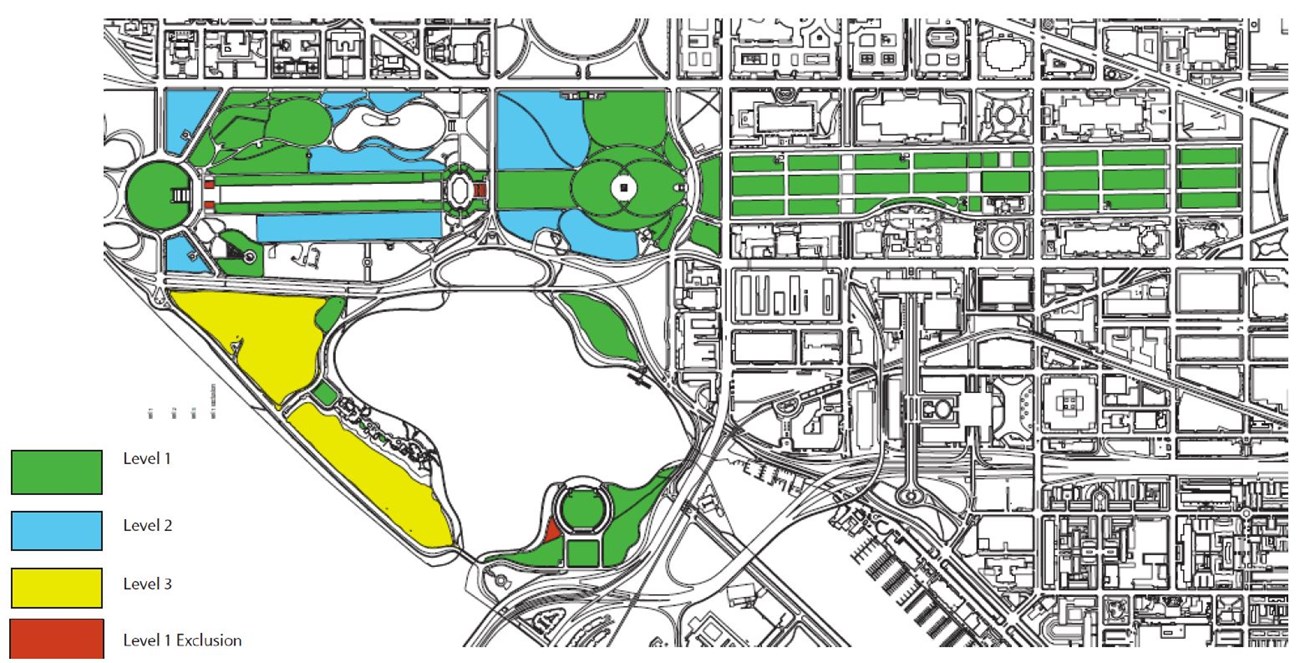
The map provides a visual reference for the locations of Turf Levels 1-3 and Level 1 Exclusion Areas on the National Mall and Memorial Parks in Washington, DC. For more detailed information and questions about using these areas for permitted activities, contact the National Mall and Memorial Parks' Permits Management Office at 202-245-4715.
Level 1 Areas are highlighted in green on the map. Level 1 Areas include parkland in and around the Thomas Jefferson Memorial, Franklin Delano Roosevelt Memorial, Martin Luther King, Jr. Memorial, Korean War Veterans Memorial, Lincoln Memorial, Vietnam Veterans Memorial, Reflecting Pool, and World War II Memorial; parkland on the Washington Monument grounds inside the internal walkways; and parkland on the National Mall between 14th Street and 3rd Street. Level 2 Areas are highlighted in light blue on the map. Level 2 Areas include parkland near the Lincoln Memorial by Daniel French Drive along Independence Avenue and by Henry Bacon Drive along Constitution Avenue; a section of the National Mall from near the Korean War Veterans Memorial to near the World War II Memorial; parkland around Constitution Gardens, parkland along Independence Avenue from 17th Street to near 14th Street; and some parkland along Constitution Avenue from 17th Street. Level 3 Areas are highlighted in yellow on the map. Level 3 Areas include the majority of West Potomac Park fields along Ohio Drive. Level 1 Exclusion Areas are highlighted in red on the map allowing one day table, chairs, and a 10-feet by 10-feet tent. Four areas are highlighted on the map, including two near the base of the Lincoln Memorial's steps; one on the steps on the east side of the World War II Memorial; and one near the southwest side of the Thomas Jefferson Memorial. 1.4 Key Team PlayersThe National Mall is in acutely high demand; its management requires diverse technical abilities and skills. Depending upon what is envisioned by an event producer, the mix of NPS staff necessary will vary by event. It is expected that the cost to support the necessary team shall be borne by the Permittee.
The special duties of these positions as related to events on the National Mall are outlined below: 1.4.1 NAMA Event CoordinatorThe NAMA Event Coordinator is the person responsible for coordinating and scheduling NPS-sponsored national celebrations, special events or activities. Events related to the Mall’s purpose and significance (see section 1.1) have priority pre-scheduling on the permits management calendar or database. This staff position resides in the Division of Interpretation and Education. 1.4.2 NAMA Permits Management Division ChiefThe NAMA permits management staff provides services not only to NAMA but also other parks within the National Capital Region (NCR). The NAMA Permits Management Division Chief assigns and manages staff to work with Permittees; to schedule, monitor, track and report on a wide variety of permitted activities; and to recover related costs. 1.4.3 NPS Permits Management SpecialistThe NPS Permit Specialist serves as the primary point of contact for the Applicant and Permittee, and coordinates with other divisions and other park staff, such as the Turf Manager. 1.4.4 Event MonitorsEvent Monitors are responsible for monitoring of the event including set up and tear down, ensuring the Permittee follows the guidelines set forth by NPS and administering the permit. Event Monitors report to the NPS Permits Management Specialist and are responsible for being onsite during the duration of the event for monitoring purposes. 1.4.5 NAMA Turf ManagerThe Turf Manager is responsible for the health and overall maintenance of the turf, soil and irrigation system. The Turf Manager generally monitors and tracks the condition of the turf to maintain a healthy turf and provides a record of conditions linked to permitted or other uses, weather conditions, or other factors. 1.4.6 NAMA Compliance Monitor(s)A variety of compliance specialists may be required depending on the nature of the event. These could include code specialists, NEPA compliance, public health and safety, law enforcement, transportation, and could include a multi-agency or incident command approach. As defined in permit conditions, the Permit Specialist may serve this role. At the discretion of the permit specialist, additional input may be required. This will be determined on an event by event basis. TURF MANAGEMENT GUIDE SECTIONS
|
Last updated: February 25, 2020

